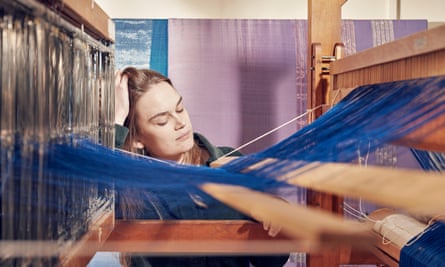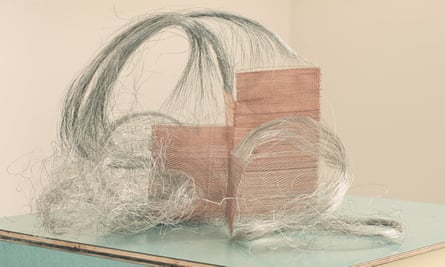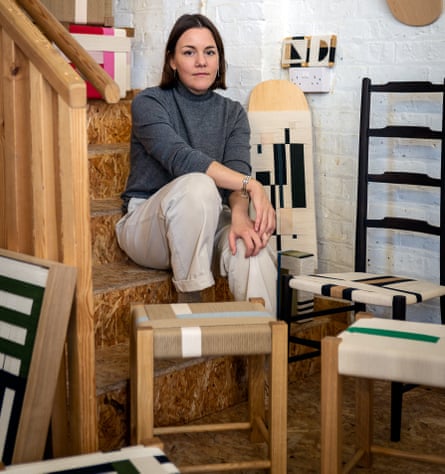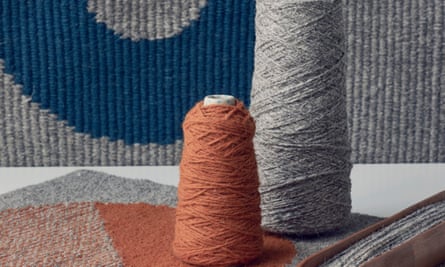From gallery spaces to Instagram, practitioners of the ancient craft of handweaving are finding new platforms for their work. This, coupled with a growing appreciation for all things handmade and an increasing awareness of the environmental impact of the textile industry, has resulted in a wave of weavers who operate at the intersection of art, craft and design.
Maria Sigma
Maria Sigma’s zero-waste textiles draw on her Greek heritage: “Ariadne” is a throw that takes its name from the heroine in Homer’s Odyssey who used a thread to help her lover, while “Theseus”, who escaped the Minotaur’s labyrinth, is made on a floor loom with wool in muted shades. The edge has been hand-crocheted in Aegean blue.
Sigma’s cushions, rugs, upholstered stools and handwoven garments are made from undyed, natural British wool, alpaca, linen and recycled cotton. “At every stage of design, I’m thinking about the environmental impact.” She studied textile conservation in Greece and textile design at Chelsea College of Art. Her loom in her east London studio is connected to a computer control unit where she loads her patterns, which include textured distorted diamonds and classic twills. “With a computer you can make much more complicated designs,” she says. “But the loom still puts you through a lot of limitations.”
mariasigma.com
Hannah Robson

Woven into Hannah Robson’s sculptural artworks are the tail hairs of Sparkle, her friend’s pony. “I pick up materials where I can find them,” Robson says. “For me, anything is ripe for weaving.”
Robson, a lecturer in woven textile design at Bradford College, creates pieces that explore the idea of connection. Inspired by the wire sculptures of Ruth Asawa and Gego, her work is equally informed by time spent at a technical textile company that made looms to create carbon fibre and carbon glass for cars and trains. “The techniques I observed there filtered into my practice.”

From her studio in Oxford, Robson uses a floor loom to “create opportunities for threads to break away from the surface”. Threads from her delicate pieces suddenly escape the loom as if coming up for air, before being twisted back into line. “I’m particularly interested in materials that are quite structural such as horsehair, metal, paper and monofilament nylons. You have to let them do their thing.”
For Robson, weaving is an outlet for endless experimentation. “A loom is a big frame around a patch of air,” she explains. “You pull these threads through and they hang together. It’s kind of magical.”
hannah-robson.com
Jo Elbourne

Drawing on the tradition of seat weaving, Jo Elbourne uses braided cotton to create geometric patterns, often using a piece of furniture as the frame. It was this “wrapping, layered thing” that brought her to the attention of Elle Decoration, who named her the winner of their British Design Award for Best in Craft in 2017. Her furniture pieces aren’t intended for everyday use. “They fit in a gap somewhere between utilitarian homeware and art object,” she says.
Elbourne is influenced by the Bauhaus movement, and minimal artists such as Donald Judd and Ellsworth Kelly. Her colour palette includes bands of soft pink, sage green and blue, often in combination with a solid block of black or scarlet. She uses synthetic dyes to create bespoke colours, mixing the dyes “to give the pieces a painterly effect”.
Working from her studio in Margate, Elbourne starts each design with a hand sketch. “I start at one corner and go all the way around, building up layers. I want the piece to feel continuous, so all the knots and joins are hidden.”
Each stool takes two to three hours to weave. “It’s pretty laborious sometimes,” she admits, “but as long as there aren’t any tangles, you get into it. That’s what I’m aiming for – that elusive flow,” she continues. “I guess that’s why anyone does anything labour intensive and complicated, because that’s the reward: that state of mind.”
jorobynelbourne.com
Christabel Balfour

London-based artist Christabel Balfour came to handweaving via a degree at Camberwell College of Art and the Ruskin School of Drawing and Fine Art. Her designs are rooted in the natural landscape. “I have lived in the capital all my life, but it’s important for me to create a sense of space and tranquillity in the middle of the city. That’s what I’m trying to do in my work, using simple imagery and calm colours.”
Her rugs and wall-hangings are woven from wool, cotton and linen and depict abstract shapes from nature that are open to interpretation. The course of a river, lunar halos and cloud formations can all be perceived in her work, as well as geometric forms and shapes translated from her own freehand drawings. “Mostly I just get started and see where it goes,” she says.

Balfour’s colour palette comprises sludgy neutrals, taupes and nudes with mustard, rust or cerulean blue making an occasional appearance. The designs are woven on one of two looms: a 40-year old Harris floor loom, and a bespoke 2m-wide upright rug loom.
“They have both needed a lot of care and work, but once you get them running smoothly it’s the best feeling in the world,” says Balfour, who runs weaving workshops in her studio.
christabelbalfour.com

Comments (…)
Sign in or create your Guardian account to join the discussion